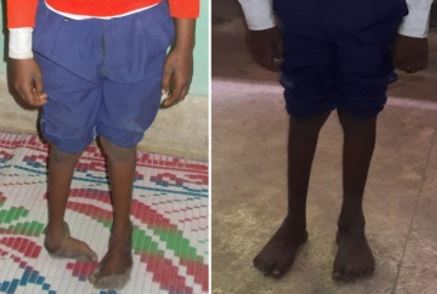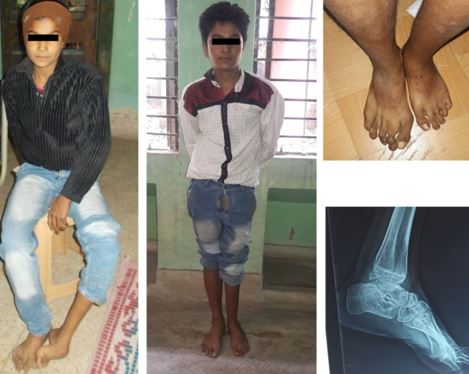Introduction
Club foot (CTEV) is one of the most common congenital musculoskeletal defects which require correction [1]. Treatment of congenital club foot deformity has changed radically with the introduction of the Ponseti method in most centres worldwide. However, most of the studies on Ponseti method are done in infants or children before the walking age [1,2].
But, in our country, late presentation for the treatment for this deformity is common problem due to social stigma, lack of education & ignorance, poverty, lack of proper health services and maltreatment. It often results in significant disability resulting in dependency for activities of daily living, significant financial and psychological impact on the family as well. Many patients with clubfoot end up living as beggars on the streets [3,4].
When the a CTEV child presents late after the walking age, the deformity becomes worse causing further contracture of the medial soft tissues and plastic deformation of bones, which makes treatment difficult. In the past decades many extensive soft tissue and bony surgeries have been performed to treat such deformities, but the results were not very promising because surgeries were associated with many complications such as poor soft tissue healing and higher relapse rate [5,6].
Some studies have shown excellent role of Ponseti method of manipulation in late presenting walking child with club foot deformity [7-10].
Inspired by these, we retrospectively analysed our cases of late presenters of congenital idiopathic club foot deformity, which had been treated in the club clinic of our institution by Ponseti manipulation technique, with the purpose to assess the role of Ponseti method in neglected club foot.
Material and methods
We retrospectively reviewed the records of 29 patients of neglected club feet deformity who had been treated in the club foot clinic of Department of Orthopaedics, at our centre, from April 2015 to March 2018 by Ponseti method of manipulation after the institutional board approval.
All children with idiopathic club foot deformity with age more than 1 year and had not taken any form of treatment previous and who were treated by Ponseti manipulation were included in the study. Secondary club foot, failed cases of previously manipulated or operated feet, atypical club foot, clubfoot deformity with ulcers over callosities for which cast could not be applied and children less than 1 year were excluded from the study.
Thus after fulfilling the inclusion criteria, only 23 cases (32 clubfeet) were included and 6 were excluded from the study. As seen from the treatment record and patient information sheet of the cases, parents of all the clubfeet children were found informed in their language, about the treatment protocol and all consented. All cases were initially evaluated by Pirani score to grade the severity of deformity [11].
Then they were treated by manipulation and regular serial weekly above knee cast application by with Ponseti’s technique of manipulation [11]. All cases were asked to review weekly and regularly in CTEV clinics for re-manipulation.
The casting and manipulation continued till, the desired position of foot achieved i.e. able to abduct 40°, which is recommended for younger children, instead of the 70°, which is desired position for infants [7]. The residual equinus deformity was corrected by a percutaneous tendoachilles tenotomy performed under local anaesthesia or short general anaesthesia in all patients.
Following tenotomy, an above knee cast was reapply with foot in 10° dorsiflexion for 3 weeks in child less than 3 years and for 4 weeks in patients more than 3 years. A repeat tenotomy of was done in children where adequate dorsiflexion, i.e., at least 10° of dorsiflexion was not achieved even after one month of first tenotomy.
In cases with residual cavus present, percutaneous plantar fasciotomy was done. After the deformity was corrected and cast removed, a foot abduction brace was prescribed to all patients for next 2 years. Initially the brace was worn for 23 hours a day for the first 3 months and after that brace wearing was done only during night time.
In our retrospective analysis we evaluated age at the time of presentation, severity of deformity by the Pirani score at initial presentation, change in the Pirani score after the final cast, the number of casts required to achieve full correction and any complications during the casting or bracing phase of the treatment.
The quantitative variables were expressed as mean ± standard deviation and compared between preoperative and postoperative follow-up using the paired t-test. Statistical analysis was performed and a P< 0.05 was considered statistically significant.
Results
23 children with 32 clubfeet deformity were included in the study. 9 had bilateral involvement whereas 14 had unilateral deformity (32 clubfeet). There were 15 male and 8 female patients. The mean age at presentation was 3.4 (range 1 to 15) years.




